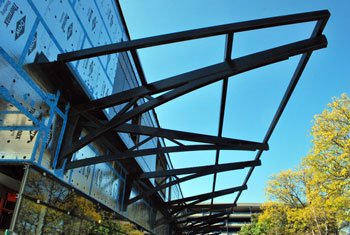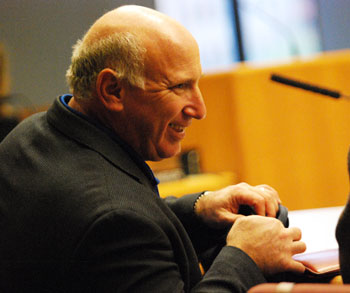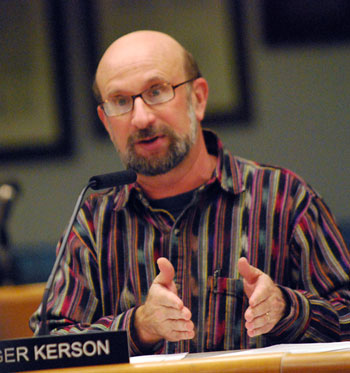AAATA Formalizes Ypsi City Relationship
Ann Arbor Area Transportation Authority board meeting (Oct. 17, 2013): The main business of the board’s meeting was the approval of a funding agreement with the city of Ypsilanti – a new member of the AAATA, and the first jurisdiction to join the authority outside of the city of Ann Arbor.

Former Y lot from the northwest corner of William and Fifth Avenue in downtown Ann Arbor, looking northwest. In the background, the new Blake Transit Center is under construction. The AAATA voted to establish a committee to meet with whatever developer makes a successful purchase offer on the lot. Also announced is that the old BTC building, located on the opposite side of the block, will be demolished in early November, somewhat ahead of the original timing. (Photos by the writer.)
The funding agreement between the AAATA and the city of Ypsilanti formalizes the existing arrangement under which Ypsilanti passes its dedicated transit millage through to the AAATA. The board approved it unanimously. The Ypsilanti city council will consider the agreement on Nov. 5.
In another piece of business that came at the end of the meeting, after a closed session that lasted about an hour and a half, the board voted to establish a subcommittee to meet with whichever developer might make the winning bid on the city-owned property at Fifth and William – known as the old Y lot. That’s an alternative to the AAATA attempting to bid on the property itself, which was listed at $4.2 million. Bids were due by Oct. 18. The city paid $3.5 million for the property 10 years ago and still owes that much on a balloon payment due at the end of this year.
An item that simply authorized the purchase of additional vehicles for the AAATA’s vanpool program had some complex history behind it – involving the federal government shutdown. The shutdown prevented the AAATA from completing its pursuit of a waiver from the Federal Transit Administration for the Buy America requirement. And the Buy America requirements were pointing the AAATA toward purchasing more expensive vehicles (Chevrolet Traverses) that did not fit the needs of passengers as well as the non-qualifying vans (Dodge Caravans). So the board opted to use local millage revenue, and to backfill the operational expenses that the millage money was covering – by using federal preventive maintenance dollars.
In a final routine item, the board authorized the AAATA’s chief executive officer to execute contracts with MDOT that are less than $1 million.
A common thread among public commentary and other board communications was the 5-year service improvement plan the AAATA has developed, and the schedule of public meetings to introduce that plan.
Editor’s note: For the AAATA’s Oct. 17 meeting, The Chronicle hired a CART (Communications Across Real Time) professional to provide a real-time “text” stream of the meeting that was accessible online through The Chronicle. The resulting transcript from that live text stream is available here: [link]. The Chronicle is experimenting with ways to make public meetings more accessible to a broader segment of the community, and to provide archival transcripts of those meetings.
Financial Terms: AAATA, Ypsi City
The board was asked to ratify its side of a transportation funding agreement with the city of Ypsilanti, which was admitted as a member of the AAATA four months ago, on June 20, 2013.
Responding to an emailed query from The Chronicle, mayor Paul Schreiber indicated that the Ypsilanti city council is scheduled to consider the agreement on Nov. 5.
That financial agreement comes as the Ann Arbor city council is set to consider at its Oct. 21 meeting the approval of another change to the AAATA’s articles of incorporation – to add Ypsilanti Township as a member of the AAATA. At the Oct. 17 board meeting, it was indicated that the AAATA would be considering a similar financial agreement with the township. That agreement would differ from the one considered by the board on Oct. 17 with the city of Ypsilanti in at least one respect – the source of funds. While the city of Ypsilanti has a dedicated transit millage, the township obtains services through a purchase-of-services agreement (POSA).
The agreement between AAATA and the city of Ypsilanti recognizes the AAATA as the public transportation provider for the city of Ypsilanti. The agreement is to transfer the full amount generated by Ypsilanti’s 0.9879 mill transit tax to the AAATA. The tax was authorized by voters in 2010 and is estimated to generate $273,797 in 2013. However, the agreement calls for the AAATA to pay the city of Ypsilanti 1% of the amount generated by the millage to cover costs that include tax assessment, billing, collection, and various city clerk responsibilities.
The agreement also establishes reporting requirements on the AAATA to the Ypsilanti city council – including submission of the AAATA’s budget for comment, provision of the AAATA’s audited financial statements, and a quarterly activity report with information on ridership, budget variations, and other service metrics. The AAATA is also supposed to keep the Ypsilanti city council apprised of any long-term decisions. The two parties agree under terms of the document to recognize that their obligation as public bodies is to “exist harmoniously for the public good.” [.pdf of resolution and AAATA-Ypsilanti agreement]
Financial Terms: AAATA, Ypsi City – Board Deliberations
Toward the start of the meeting during communications time, Gillian Ream Gainsley – who represents the city of Ypsilanti on the AAATA board – reported that she’d attended the Ypsilanti city council meeting on Tuesday, just to speak in favor of the council’s support for the city joining the authority. She indicated that she felt there was a lot of support for the two cities to be working together on transportation service.
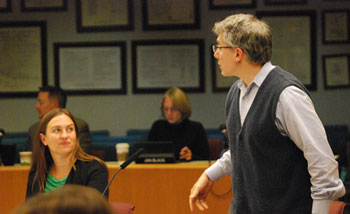
Standing is board member Jack Bernard. Seated is Gillian Ream Gainsley, a board member who represents Ypsilanti.
When he reported out on the items from the performance monitoring and external relations committee, Roger Kerson noted that Jack Bernard [a board member who's an attorney in the University of Michigan's office of the general counsel] had raised the question of what happens if there’s a breach of the agreement on either side. If the money doesn’t arrive from Ypsilanti, does AAATA have the right to terminate service, or if the AAATA terminated service, would both parties be in breach? While Bernard had flagged that issue, it seemed like a very unlikely occurrence, so the committee was comfortable with the agreement as written.
When the board came to the item on its agenda, Kerson described the agreement as formalizing the relationship that already exists. It puts in writing that the funds generated from Ypsilanti’s transportation millage will flow through to the AAATA on an indefinite basis. Those funds will automatically flow to the AAATA, and that stabilizes the AAATA’s finances, enables long-term planning and is a good way to continue the good faith relationship, he said.
Ream Gainsley added the understanding had always been that the city of Ypsilanti’s dedicated transit millage would flow directly to the AAATA, so the agreement was in everyone’s interest.
Board chair Charles Griffith ventured that if the Ann Arbor city council were to approve membership of Ypsilanti Township in the AAATA at its Oct. 21 meeting, then a similar agreement would be executed with the township. CEO Michael Ford confirmed Griffith’s understanding.
Outcome: The board voted unanimously to approve the financial agreement between the AAATA and the city of Ypsilanti.
Subcommittee on Y Lot
The board considered a resolution related to the city-owned parcel on William between Fourth and Fifth avenues in downtown Ann Arbor, known as the old Y lot. The resolution established a committee to meet with whatever party might make a successful purchase proposal for the city-owned parcel.
The resolution to form a subcommittee – whose members aren’t yet identified – is an alternative to bidding to purchase the property.
The AAATA has historically been interested in the property, which is immediately south of the AAATA’s downtown Blake Transit Center. The city’s purchase of the land in 2003 followed an attempt by the AAATA to acquire and develop the parcel. The AAATA continues to envision the block as a center of transit activity.
The property was listed at $4.2 million with purchase offers due by Friday, Oct. 18. The AAATA board resolution indicates in a “whereas” clause that any offers are expected to be brought to the Ann Arbor city council’s Oct. 21 meeting. The resolution is based on the idea that the AAATA wants to establish good relations with any potential developer of the site.
The subcommittee of the board is supposed to meet with developers and take part in future negotiations.
The city council is exploring whether to sell that property, which is also across from the downtown Ann Arbor District Library. Earlier this year, the city selected Colliers International and local broker Jim Chaconas to handle the possible sale, as the city faces a $3.5 million balloon payment this year from the purchase loan it holds on that property. The city has owned the land for a decade.
Now a surface parking lot, the site was zoned D1 as part of the original A2D2 (Ann Arbor Discovering Downtown) zoning process. The site was also one of five parcels that was the focus of the Ann Arbor Downtown Development Authority’s Connecting William Street project, and was part of a more recent evaluation by the city’s park advisory commission as a potential downtown park.
Two months ago, at its Aug. 20, 2013 meeting, the Ann Arbor city planning commission made recommendations on the development of the former Y lot. Among others, those recommendations included: a building that generates foot traffic, provides a human scale at the ground floor and creates visual appeal; a “mixed use” development; and a building with vehicular access and parking that are accessed via the city’s new Library Lane underground parking structure.
Subcommittee on Y Lot: Board Deliberations
The AAATA board resolution was not originally on the agenda, although a closed session did appear on the agenda. That closed session came at the end of the meeting and lasted about an hour and a half. Land acquisition is one of the reasons that a public body can enter into a closed session under Michigan’s Open Meetings Act.
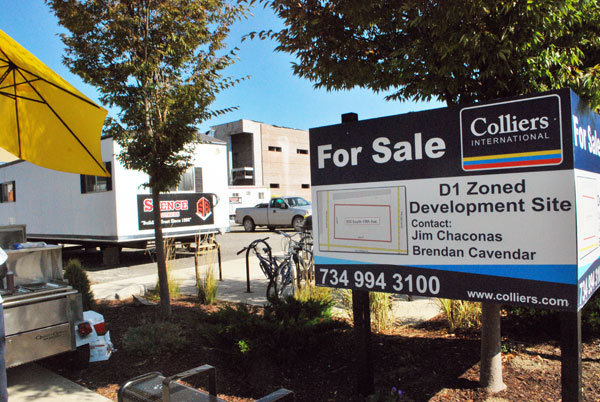
Old Y lot from the northeast corner of Fourth Avenue and William Street. Part of the site, now a surface parking lot, is being used as a staging area for construction of the AAATA’s new Blake Transit Center.
When the board emerged from the closed session, Roger Kerson read aloud the resolution and gave some commentary on it. Kerson chairs the AAATA’s performance monitoring and external relations committee.
Kerson described the formation of a subcommittee to engage the eventual developer of the site as an alternative to the AAATA purchasing the property.
Even though making a successful bid for the property would give the AAATA complete control, Kerson said, it’s not practical for the AAATA to make a bid at this time – as it would deplete the AAATA’s financial reserves.
So instead, Kerson said, the AAATA should be proactive and engage with whomever the city selects as the successful bidder. The AAATA could make its needs known to the developer with respect to providing transit. The idea would be possibly to help the developers meet their needs and simply be a good neighbor. Kerson said it would be best to engage early, instead of waiting to review something that a developer might come up with, without the AAATA’s input. The subcommittee would actively engage that process, Kerson concluded.
Outcome: The board voted unanimously to approve a resolution to form a subcommittee of AAATA board members to meet with the future developers of the old Y lot.
Subcommittee on Y Lot: BTC Construction
Also at its Oct. 17 meeting, the AAATA board was updated regarding progress on construction of a new transit facility immediately adjacent to the old Y lot.
Completion of the new Blake Transit Center building, located on the Fifth Avenue side of the lot, is now expected toward the end of January 2014, which is about six weeks later than originally planned. The old building, which stands on the Fourth Avenue side, was originally not planned for demolition until the new building was complete. However, because the construction schedule has slipped and AAATA staff are concerned about a hard winter arriving and stalling the demolition schedule, the AAATA is planning to demolish the old building sooner than that.
The strategy will be to use trailers as a temporary substitute for the building. Terry Black, AAATA manager of maintenance who’s supervising the construction, explained that the target date for transitioning from the old building to trailers is Oct. 28. During the week of Oct. 28, the move will be made out of the old building, and then on the weekend of Nov. 2-3 the building will be torn down.
Vanpool Vehicles
The final form of the item on the agenda authorizing vanpool vehicle purchases evolved through a couple of different iterations – due in part to the federal government shutdown.
A vanpool is essentially a group of people who are provided a vehicle, and charged a price for the use of that vehicle so they can drive to work together. According to CEO Michael Ford’s written update to the board, the AAATA’s vanpool program currently has 44 active vanpools.
The resolution in its final form authorized the purchase of up to 40 vehicles for the AAATA’s vanpool program to replace aging vehicles, as well as to meet additional demand for the program. The vans will be either Dodge Caravans (mini-vans) at $21,356 from Snethkamp of Lansing, or Ford Econoline vans (full-size vans) from Gorno of Woodhaven, at $20,940.
According to the resolution, the Ford Econoline meets the conditions of the Federal Transit Administration’s Buy America program – which require 65% American components and final assembly in the United States. The Dodge Caravan meets the 65% American-made component requirement, but is assembled in Canada – with union labor. So the funding of the Caravan, which does not meet all the FTA’s Buy America criteria, will be drawn from local millage money, while the Ford vehicles will use federal funds.
According to AAATA manager of service development Chris White, operations that the local millage money would have covered will instead be paid for with federal dollars.
Vanpool Vehicles: Background on Resolution
Minutes from the AAATA’s planning and development committee meeting earlier in the month indicate the original proposal was to purchase 25 vans, with the option of 10 additional vans. And according to the minutes of the Oct. 8, 2013 committee meeting, at that time the AAATA estimated that during the current fiscal year, a total of 35 vans – either to replace aging vehicles or to provide a vehicle for new vanpools – would be needed.
The AAATA’s preferred approach would have been to use a Buy America waiver to purchase Dodge Caravans, which the Federal Transit Administration had granted back in May 2012 when the AAATA began its vanpool program. However, a year ago, in November 2012, the FTA rescinded the Buy America waiver for Dodge Caravans. But in rescinding the waiver, the FTA also provided a way for a transit authority to petition the FTA for waivers on a case-by-case basis.
According to an Oct. 16 memo from CEO Michael Ford to the board, the AAATA had begun working with the FTA in May 2013 to obtain a waiver for Dodge Caravans.
However, because of the federal government shutdown, FTA representatives overseeing the Michigan area were not able to consider the AAATA’s request for waiver on FTA’s Buy America program for the Dodge vehicles. So the request originally placed on the agenda was just to buy 10 Buy America compliant vehicles right now, in order to meet immediate needs. The vehicles specified in the initial version of the resolution were for the Chevrolet Traverse – which is a “crossover” vehicle something like an SUV or a van – to be sourced from LaFontaine Chevrolet of Dexter at a cost of $28,175 each. While the Traverse met the Buy America standard, only 10 were to be purchased, because AAATA staff didn’t feel the vehicle would meet the needs of vanpool riders.
After that resolution was prepared, according to Ford’s memo to the board, additional requests for vanpools were received, which bumped the estimated total number of vehicles needed for the next fiscal year to 40.
That led the AAATA to pursue the strategy of using local millage money for the Dodge vans, but federal funds for the Fords. Vehicles purchased with local millage money are not subject to Buy America requirements. The local revenue would otherwise be used for operations. The federal grant funds that would have been used to purchase the vehicles were transferred from the vanpool vehicle line item to the preventive maintenance line item. Preventive maintenance is considered operating revenue.
The argument for that strategy expressed in Ford’s memo was that purchasing more expensive vehicles ($28,175 each for the Chevrolet Traverse compared to $21,356 each for the Dodge Caravan) would have been a lose-lose proposition, because the vehicles did not meet the purpose of the program as well as the less-expensive vehicles.
Vanpool Vehicles: Board Deliberations
Eli Cooper led off deliberations by appealing to the “base definition” of the program: “It is a vanpool program. It is not the SUV crossover program!” He ventured that anybody who is familiar with the difference between the amount of useable room inside a minivan [Dodge Caravan] compared to a small SUV [Chevrolet Traverse] would recognize the higher level of comfort and convenience for vanpool riders.
Cooper also stressed the cost difference between the two vehicles: $28,175 each for the Chevrolet Traverse compared to $21,356 each for the Dodge Caravan. About the Traverse, Cooper said: “They are not vans.” The Traverse could accommodate seven passengers, but “if you are anything older than ten years old, then try to
get into the back row, the third row seating in a Traverse!” Cooper said he didn’t think that’s the right way for the AAATA to treat its customers.
Cooper reviewed the issue with the Buy America waiver, allowed that a waiver might have been forthcoming. The older vehicles, inherited from the MichiVan program, are wearing out and need to be replaced. He said there was not time for the crisis in government to be resolved before bringing the resolution forward. Cooper said he was glad that staff was creative enough to find a way to be flexible about the funding so that the vehicles could be purchased.
Earlier in the meeting during his report from the performance monitoring and external relations committee, Roger Kerson commented on the Buy America policy as it relates to the Dodge Caravan.
He described it as the preferred vehicle, which is assembled in Canada, and thus does not meet the Buy America requirements. He told his colleagues that he knew a lot about this from his work for the UAW – that the Caravan is a vehicle made by union members in Canada. [Kerson was head of public relations for the UAW for three and a half years, through 2009.] Kerson pointed out that the UAW’s website promotes the Caravan as a union-made vehicle, and the Caravan has many American parts.
Kerson told his board colleagues that personally he owns a Caravan. He said that purchasing a Caravan supports jobs in Michigan – because the engine, powertrain and many of the key components are made in the U.S. before being trucked over to Windsor for final assembly.
Outcome: The board voted unanimously to approve the vanpool vehicle purchases.
MDOT Contract Authorization
The board considered a resolution giving CEO Michael Ford authorization to execute all contracts with the Michigan Dept. of Transportation that are less than $1 million for the next fiscal year, through Sept. 30, 2014.
It’s a routine annual authorization. Other than a brief description from Roger Kerson, there weren’t any substantive deliberations on the topic. Ford is expected to report to the board on all the contracts he executes under this authorization.
Outcome: The board voted unanimously to authorize the CEO to execute contracts with MDOT that are less than $1 million.
Communications, Committees, CEO, Commentary
At its Oct. 17 meeting, the board entertained various communications, including its usual reports from the performance monitoring and external relations committee, the planning and development committee, as well as from CEO Michael Ford. The board also heard commentary from the public.
The main highlight with threads across different points in the board’s meeting was the 5-year plan for service improvements that the AAATA is proposing. The service improvements would be implemented if additional funding is provided, likely in the form of a millage to be levied by the AAATA itself. The amount of the additional tax levy would be about 0.7 mills. No decision has yet been made by the board to place a millage before the voters, but that could take place as soon as May 2014.
The current efforts of the AAATA to increase service frequency, times and geography are the outcome of a demised effort to create a countywide authority in 2012. The Ann Arbor city council subsequently gave direction to the AAATA to focus its efforts on the communities that are located more geographically near Ann Arbor. With the addition of the city of Ypsilanti and Ypsilanti Township (pending Ann Arbor city council action on Oct. 21), about 50% of the county’s population live in a member jurisdiction.
Comm/Comm: 5-Year Service Plan – CEO Remarks
Board member Eli Cooper and CEO Michael Ford both noted that the staff had participated in a city council work session earlier in the week, on Oct. 14, 2013. The “urban core” implementation program focuses on local improvements for Ann Arbor. As part of the program, the city of Ann Arbor would receive a 33% increase in service. Additional meetings are scheduled. Ford reported that staff continues to meet with community leaders and elected officials to gain their support and interest in the process.
Comm/Comm: 5-Year Service Plan – First Meeting
Board member Jack Bernard reported that he’d attended the first of the 5-year service plan public meetings, which took place just before the Oct. 17 board meeting. There are a lot more of them scheduled, he said. Chris White and Michael Benham had done a fantastic job talking with the first group of people, Bernard reported. The presentation went smoothly, and the questions from the public were fielded very well. It was really wonderful to see the interaction between the staff and the public, Bernard said.
Comm/Comm: 5-Year Service Plan – Impact on Taxicab Drivers
During public commentary at the first 5-year service plan meeting, which took place on Oct. 17 from 4-6 p.m. – before the 6:30 p.m. AAATA board meeting – Bill Higgins addressed the staff about concerns he had as a cab driver. He reprised his remarks at the board meeting during public commentary. [This is not the same Bill Higgins who recently attended a community meeting on sidewalk construction on Scio Church Road.]
Higgins said he’d been a cab driver for about 25 years and has ridden the AAATA buses probably for 40 years. He told the board that the bus service is squeezing the cab drivers. As an example, he described the AAATA’s AirRide service between downtown Ann Arbor and Detroit Metropolitan Airport as $7. [The fares listed on the AirRide website show fares in that range only for senior rides, at $7.50. Standard fare for a walk-on, for example, is $15 for a one-way trip.] If the rate were $12, then he felt he’d have a chance to compete.
The art fair shuttle offered by the AAATA has the same negative impact, he said. On football Saturdays, the AAATA’s shuttle service also has a negative impact on the ability of taxicab drivers to earn a living, he said. Another AAATA program that’s eating into the taxicab business is the University of Michigan MRide program, which allows UM students to get rides on AAATA buses without paying a fare to board. Instead of paying for a cab to go shopping, they just take the bus.
Increasing the hours of service, he said, would keep putting the squeeze on taxicab drivers, he said, who are just barely making enough money to live in Ann Arbor.
Present: Charles Griffith, Eric Mahler (arrived later in the meeting), Susan Baskett, Eli Cooper, Roger Kerson, Anya Dale, Gillian Ream Gainsley.
Absent: Sue Gott.
Next regular meeting: Thursday, Nov. 21, 2013 at 6:30 p.m. at the Ann Arbor District Library, 343 S. Fifth Ave., Ann Arbor [Check Chronicle event listings to confirm date]
The Chronicle could not survive without regular voluntary subscriptions to support our coverage of public bodies like the Ann Arbor Area Transportation Authority. Click this link for details: Subscribe to The Chronicle. And if you’re already on board The Chronicle bus, please encourage your friends, neighbors and colleagues to help support The Chronicle, too!




